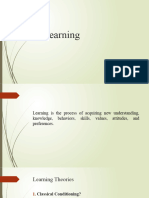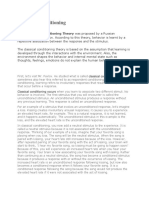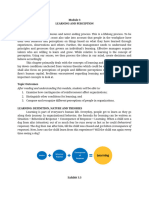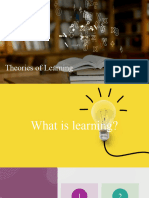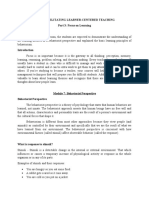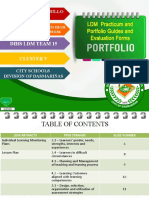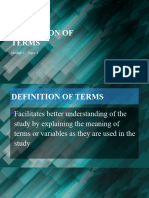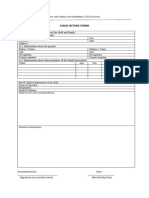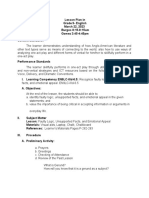Learning and Reinforcement
[Type here]
Table of Contents
Learning ................................................................................................................................................. 2
Nature of Learning ........................................................................................................................................... 2
Theories of Learning......................................................................................................................................... 2
Classical Conditioning ................................................................................................................................................................ 3
Operant Conditioning ................................................................................................................................................................ 4
Cognitive Learning ..................................................................................................................................................................... 5
Social Learning ........................................................................................................................................................................... 5
pg. 1
�[Type here]
Learning
Learning is a change in behaviour through education and training, practice and experience. It is accompanied
by the acquisition of knowledge, skills and expertise which are relatively permanent.
E.R. Hilgard has defined learning as a relatively permanent change in behaviour that occurs as a result of
prior experience. Ironically, it can be said that a change in behaviour indicates that learning has taken place
and that learning is a change in behaviour.
Nature of Learning
Based on the definition of learning, we can identify the nature of learning-
• Learning involves a change in behaviour, though the change is not necessarily an improvement over
the previous behaviour. Learning generally has the connotation of improved behaviour, but bad
habits, prejudices, stereotypes, and work restrictions are also learned.
• The behavioural change must be relatively permanent. Any temporary change in behaviour due to
fatigue or any reason is not a part of learning.
• The behavioural change must be based on some form of practice or experience. Thus, any
behavioural change because of physical maturation is not learning. For instance, the ability to work
which is based on physical maturation would not be considered learning.
• The practice or experience must be reinforced for learning to occur. If reinforcement does not
accompany the practice or experience, the behaviour will disappear.
Theories of Learning
Classical Conditioning
Operant Conditioning
Cognitive Conditioning
Social Behaviour
pg. 2
�[Type here]
Meaning of Conditioning
The process of training or influencing a person or animal mentally so that they do or expect
a particular thing without thinking about it.
Example: Conditioning starts as soon as boys are given guns to play with and girls are given
dolls.
Classical Conditioning
Classical conditioning states that behaviour is learned by a repetitive association between a stimulus and a
response (S-R association). The organism learns to transfer a response from one stimulus to a previously
neutral stimulus. Four elements are present in classical conditioning:
- Unconditional Stimulus (US) – like food which invariably causes to react in a certain way, that is,
salivation
- Unconditional Response (UR) – takes place whenever the food is presented, that is, whenever the
organism (dog for example) is given food, it salivates.
- Conditional Stimulus (CS) – the object that does not initially bring about the desired response like
the sound of the bell
- Conditioned Response (CR) - a particular behaviour that the organism learns to produce to the CS,
that is, salivation
The work of the famous Russian physiologist and Nobel Prize winner, Ivan Pavlov demonstrated the classical
conditioning processes.
A simple surgical procedure permitted Pavlov to measure accurately the amount of saliva secreted by a dog.
In the experiments, when Pavlov presented a piece of meat (unconditioned stimulus) to a dog, he noticed a
great deal of salivation (unconditional response).
On the other hand, when he merely rang a bell (neutral response), the dog had no salivation. Thus, it was
established that the ringing of the bell was having no effect on salivation.
In the next step, Pavlov accompanied meat with the ringing of the bell. On this, the dog salivated. This
experiment was repeated several times.
After that, Pavlov rang the bell without presenting the meat, and the dog salivated to the bell alone which
was originally a neutral stimulus having no effect on the behaviour (salivation). In the new situation, the dog
has become classically conditioned to salivate (conditioned response) to the sound of the bell (conditioned
stimulus)
Here Pavlov conditioned the dog to respond to a learned stimulus. It can be also called the “law of exercise”
which states that behaviour can be learned by a repetitive association between a stimulus and a response.
Thus, under classical conditioning, learning is a conditioned response which involves building up an
association between a conditioned stimulus and an unconditioned stimulus. Using the paired stimuli, one
compelling and the other neutral, the neutral one becomes a conditioned stimulus and hence, takes on the
properties of the unconditioned stimulus.
pg. 3
�[Type here]
This happens quite often in an organisational setting. In one case, there was a cleanliness drive in a hospital
to prepare for inspection by the top officials of the health ministry. Here the nurses and other staff showed
great attention to their duties. This practice showed their utmost attention to duties. This practice continued
for a considerable period. Eventually, nurses and other staff showed their utmost attention to duties
whenever the cleanliness drive was carried out in the hospital even though it was not linked with the
inspection by the health ministry official.
Operant Conditioning
Operant is defined as behaviour that produced an effect. Operant conditioning is based on the work of
B.F.Skinner advocated that individuals emit responses that are rewarded and will not emit responses that
are either not rewarded or are punished.
It is a voluntary or learned behaviour and it is determined, maintained and controlled by its consequences.
Operant conditioning is based on the premise that behaviour is a function of its consequences. People learn
to behave to get something they desire or avoid something they dislike. Behaviour is likely to be repeated if
the consequences are favourable and it is not likely to be repeated if the consequences are unfavourable.
Thus, the relationship between behaviour and consequences is the essence of operant conditioning.
The term ‘operant’ indicates that the organism operates on its environment to generate consequences. The
relationship between consequences and response summarises quite concisely a basic learning process that
occurs over time, in which a person changes his behaviour based on his experience.
Reinforcement strengthens behaviour and increases the likelihood that it will be repeated. This is the
essence of operant conditioning.
pg. 4
�[Type here]
Operant conditioning is a powerful tool for managing people in organisations. Most behaviours in
organisations are learned, controlled, and altered by the consequences, i.e., operant behaviour.
Management can use the operant conditioning process successfully to control and influence the behaviour
of employees by manipulating the reward system. If a manager wants to influence behaviour, he must also
be able to manipulate the consequences that are rewarding and increases the rate of response, while the
aversive consequences decrease the rate of response.
Difference between Classical and Operant Conditioning
Cognitive Learning
Cognitive learning is learning achieved by thinking about the perceived relationship between events and an
individual’s goals and expectations. For instance, the process motivation theories deal with explaining
“why” people decide to do things. They do so by examining how people come to view various work activities
as perceived opportunities to satisfy needs, pursue desired rewards and eliminate felt inequities.
Cognition refers to an individual’s ideas, thoughts, knowledge, interpretations, understandings, etc.
The cognitive theory of learning assumes that the organism learns the meaning of various objects and events
and learned responses depend upon the meaning assigned to stimuli.
The cognitive theory recognises the role of an organism in receiving, memorising, retrieving, and
interpreting the stimulus and reacting to it.
Social Learning
Social learning was introduced by Psychologist Albert Bandura and refers to the learning achieved through
the reciprocal interactions between people, behaviour and their environment. Social learning theory
integrates cognitive and operant approaches to learning. It recognises the importance of consequences as
determinants of behaviours. It also emphasizes that people acquire new behaviours by observing and
imitating others in the social setting.
pg. 5
�[Type here]
Learning is not a case of environmental determinism (classical and operant views) or of individual
determinism (the cognitive view). Rather, it is a blending of both. Thus, social learning theory emphasizes
the interactive nature of cognitive, behavioural, and environmental determinants of human behaviour.
People learn through observation and direct experience. Social learning theory is a behavioural theory. It
draws heavily from classical and operant conditioning concepts and even goes beyond that.
Besides antecedent stimuli and contingent consequences, social learning can also take place via:
- Modelling or vicarious learning
- Symbolism
- Self-control
In fact, we are all influenced by models such as parents and other family members, teachers, etc from our
childhood.
Modelling: Through vicarious learning or modelling, people acquire behaviours by directly observing and
imitating others. When the “model” such as the manager or a co-worker, demonstrates desirable behaviour,
it can have a major impact on a person’s work efforts. Many patterns of behaviour are learned by watching
the behaviour of models such as parents, teachers, superiors, film stars, etc.
The influence of models is central to the social learning viewpoint. The following processes determine the
influence that a model will have on an individual:
Attentional Process: People only learn from a model when they recognise and pay attention to its critical
features. We tend to be most influenced by models that are attractive, repeatedly appearing, which we think
are important, or we see as similar to us.
Retention Process: A model’s influence will depend on how well the individual remembers the model’s
action, even after the model is no longer readily available.
Major Reproduction Process: After a person has seen a new behaviour by observing the model, the matching
must be converted into doing. This process demonstrates that the individual can perform the modelled
activities.
Reinforcement Process: Individuals will be motivated to exhibit the modelled behaviour if positive incentives
or rewards are provided. Behaviours that are reinforced will be given more attention, learned better and
performed more often.
pg. 6



















